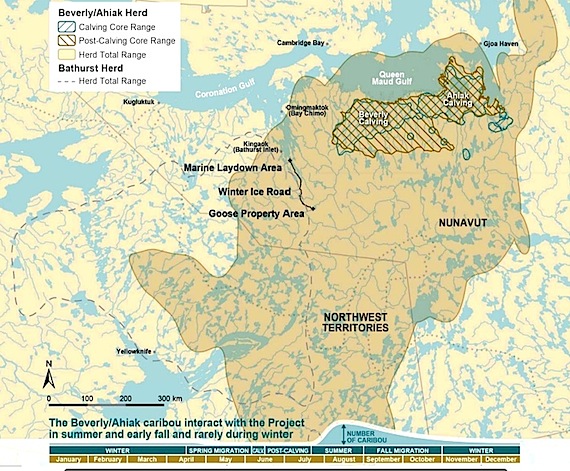Caribou again dominate Western Nunavut gold mine project review
Sabina Gold and Silver Corp. pitched its gold mine project again last week in Cambridge Bay with a 72-page exhaustive new plan to mitigate, manage and monitor any impacts to the three caribou herds and other wildlife near its proposed Back River gold mine in western Nunavut.
This was the second round of environmental hearings on Sabina’s Back River project in Cambridge Bay. The first, which took place in 2016, resulted in a negative recommendation from the Nunavut Impact Review Board—and, with the additional mitigation, management and monitoring efforts, Sabina says it’s even, “more confident that there will be no impacts on caribou herds.”

Sabina’s plans for Back River include a chain of open pit and underground mines at its Goose property, located 400 kilometres south of Cambridge Bay and 520 km north of Yellowknife.
The pits would operate for at least 10 years and involve filling, damming or draining lakes and streams, and building a 157-km road from the mine to a seasonal port facility and tank farm in Bathurst Inlet.
Yet, all that infrastructure would be created on lands through which the Bathurst and Beverly caribou herds migrate. In recent years, the population of the Bathurst herd has plunged to as few as 20,000 animals, down from nearly half a million 30 years ago.
Sabina says there is no overlap of its project, called Hannigayok in Inuinnaqtun, with the Dolphin/Ahiak herd and that it lies outside the Bathurst herd’s current range.
The four-day review, from May 31 to June 3, marked the first time in 20 years that the NIRB had been asked to reconsider a decision on a project and go back into another review process.
But the new hearings and roundtable took place at the behest of the federal government.
Indigenous and Northern Affairs Minister Carolyn Bennet said this past January that there was “insufficient information” to support the NIRB’s decision in June 2016 to reject the project, adding “further information,” was needed.
Sabina’s planned caribou protection measures came under heavy criticism during the first hearings and roundtable held last April, with the governments of Nunavut and the Northwest Territories saying the company needed to do more and act more quickly to protect barren ground caribou herds.
The goal of Sabina’s new plan, introduced last week is to show there is, “no impact to caribou herds caused by the project.”
But not everyone in Cambridge Bay was persuaded that promised jobs for residents of the Kitikmeot region from the mine—65 during its four-year construction period and 194 during the mine’s 10-year operating life—is worth any risk of impact on caribou.
That concern prompted Jana Angulalik, 27, to stand up June 2 to make some passionate comments she shared with Nunatsiaq News.
“I believe this mine is based on money, and money alone,” she said. “Some of you think that the prospect of jobs outweighs the fears of harm to caribou. Sure you say that you’ll give us jobs. But what I say to that is, that is the easy way out and if our government and our associations take the easy way out and accept this mine, then they are all nothing short of lazy. We need to find other ways in which we can create jobs that don’t require the nuna [land] to be torn apart and its natural resources extracted.”
The cultural connections of Inuinnait to caribou shouldn’t be exchanged for money, Angulalik told those gathered at the Luke Novoligak Community Hall.
“You say that the money you make can help our communities grow and prosper but again that is the easy way out because what happens in 14 years when the mine closes and the land is ruined and our tuktu [caribou] in the area are no longer existent,” she said.
But Sabina maintains its new wildlife management and monitoring plan is more protective of marine and terrestrial wildlife: “We are confident that our measures are equal to or more protective than the measures in place at other mining operations.”
With respect to caribou, those measures include a rapid shutdown if calving takes place near the mine site and if one or more caribou is observed on site, reactions include a slow-down of traffic—among other measures.
As well, the winter ice road to the marine landing area will close by April 15 to avoid spring migration and include monitoring and road closure if caribou are seen crossing the winter ice road.
Sabina said it will also create an Inuit advisory group and caribou technical advisory group in addition to working with governments of the NWT and Nunavut to help monitor the herds.
The Kitikmeot Inuit Association President Stanley Anablak said in a statement obtained by Nunatsiaq News Sabina’s mitigation and commitments “represent the state of the art in Arctic Canada”
In his closing statement he said Sabina had made important changes to the Back River project.
“These changes improve environmental protection and reduce the potential for this project to have any impact on the environment. Because of the NIRB process and
the hard work of everyone involved, KIA concludes that a good project has been made better,” Anablak said.
The NIRB plans to issue a new recommendation on Back River by July 18.
Sabina has said a positive recommendation for the project could see work get underway as early as next year, in 2018.